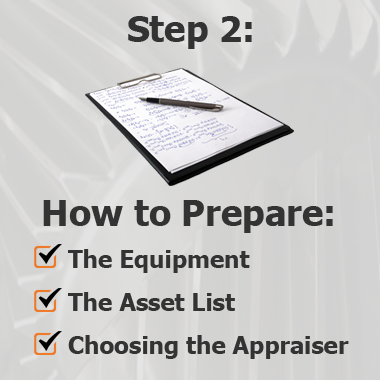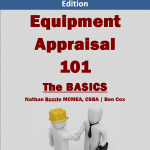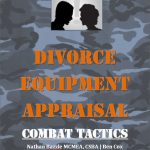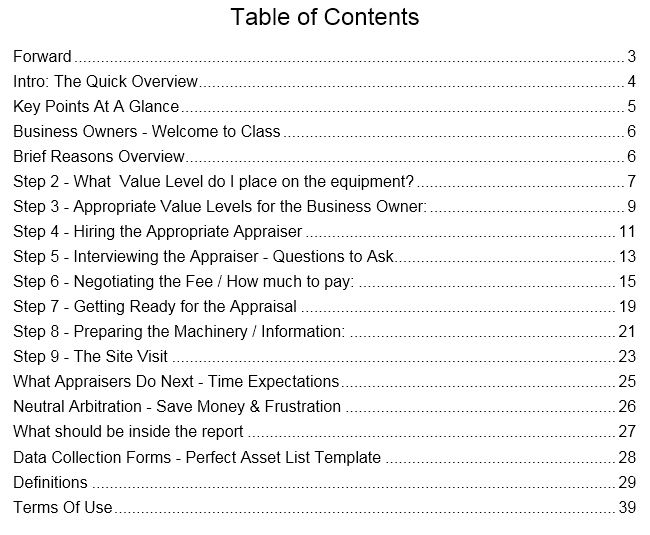Equipment Appraisal – save Time, Money, and Frustration by doing the following.
Note: Some advice given is tactical – please consult your Attorney, Accountant, or other Trusted Adviser before implementing.
Save Time on Your Equipment Appraisal by creating a good asset list before your appraiser starts. A good place to start is the depreciation schedule. Be sure to update the list with any new equipment items purchased and remove any defunct items. See more advice below… or our post on “How to speed up your Equipment Appraiser”.
Save Money on Your Equipment Appraisal by having an updated asset list, choosing to individually appraise only larger items and grouping smaller items like hand tools, and if able choosing a desktop equipment appraisal when appropriate. See our eBook section on negotiating a fee / how much to pay for more insights into this.
At this point, we want to stop and point out that we offer FREE ADVICE…
Call our Appraisal Strategists to get your Questions Answered
800-785 6061
and ask for our Free Equipment Appraisal Tool Kit
The Free Equipment Appraisal Tool Kit Includes:
-
A Free Consultation with our Appraiser Strategist
-
The Equipment Appraisal 101 eBook or our Divorce Equipment Appraisal eBook
These are also available on Amazon if desired.
-
Your personal Equipment Appraisal Checklist and Planner

-
Our Proprietary Data Collection Sheets
(Emailed Upon Request)
-
Many other tools that our Appraisal Strategist can send to help you simplify your appraisal process. (Talk to our Strategists to determine what fits your unique needs)
eBook Examples:
Here is a table of contents from our eBook as a sample
The Asset List for Equipment Appraisals
Tactical Note: Be sure to purge / update your Depreciation Schedule / Asset list before having the Appraiser quote the fee. This will save both yourself and the Appraiser frustration with missing or added Equipment. These missing or extra items will potentially cause problems with the party requiring this Appraisal.
Now that you have a good depreciation schedule / asset list of the items you are needing to appraise, it is time to collect the data for the Appraiser. Note: You may be having the Appraiser come Onsite for this purpose. In that instance, please make sure your Asset List has good General Descriptions.
We find that data collection and cleaning / preparing the equipment go hand-in-hand (See more below).
The first part of any machinery appraisal is making sure your asset / machinery list is up-to-date and as complete as possible. Many times we see this list several years outdated and with vague references to the equipment. This often leads appraisers to charge more as they find equipment while onsite or worse to inflate the price going in because they know the asset list is poor, and they are “hedging their bets”. Both of these scenarios will cost you more $’s than needed.
Let’s start by looking at what the perfect asset list should look like. There are some key elements to a perfect asset list that, if followed, could easily save your business thousands of dollars on a machinery appraisal (at least when dealing with us…). Here are the components of a perfect asset list:
-
General Item / Property Name – Example: Bulldozer, Computer, Address of Property, General Description of Improvement, Etc.
-
Location of Item or Property (If Applicable or if Item is not onsite – add into Description Box)
-
Make of Item – Caterpillar, Dell, Etc.
-
Model of Item – Example: D-11, Inspiron M17, Etc.
-
Year of Item – Year the Equipment was Manufactured
-
Description: Includes – Serial Number, VIN, General Description, Specifications, and Options Included
-
Year of Purchase
-
Cost to Purchase
-
Current Depreciation Amount (Not needed by us)
-
Item Tag / Internal Asset Number (If Applicable, put into the Type / # Column)
-
General Specifications of the Machine – i.e., Size, Weight, # of Miles / Hours, Specifications, Options (Add into the Description Column)
Remember: More information is Better
Preparing the Equipment
Tactical Note: How clean or dirty a machine is CAN impact a visual inspection and potentially impact value. If you need a higher value, we suggest doing a deep clean of the equipment / work area / and potentially the shop. If you need a lower value, then you may want to leave it a mess. The reason for this is simple – cleaner machinery makes the Equipment Appraiser feel like better maintenance and better resale should be considered. (Note: A Good Appraiser will see past this)
Ideas for Cleaning the Equipment:
Appraisers are not generally mechanics or technicians. The Appraiser has to rely many times on what they see and hear. If you say, “I just rebuilt this machine” and it looks like a rusted piece of junk, you will probably need to convince the Appraiser with documentation to back up your claim.
Organizing the Equipment – Everything in its place. It will make the Appraisal go so much quicker if all the machinery is organized and the building / yard can be easily navigated. Also, being able to find machinery and miscellaneous parts is critical for the Appraisal (More on this in the Asset List Section).
Cosmetic Repair – Fix all exterior parts of the equipment. Consider repainting with original colors, degreasing parts, and generally detail-cleaning the machine.
Work Area Cleanup – Grab that bottle of glass cleaner / degreaser. Have the person who works at that station clean-up the tooling, lunch wrappers, and at least organize the miscellaneous paperwork (especially if it’s covering the machine’s make and model numbers).
Building Cleanup – Now is the perfect time to replace burned out light bulbs and do a fantastic sweeping job. If your building looks like a Cave, your appraiser will have a hard time feeling you have “Top Value” equipment.
Maintenance Records – The best maintained equipment always has a good record showing that maintenance. We have seen it in many forms, electronic records, and sign-off sheets. During an Equipment Appraisal the best option is to give us an electronic copy that is easily attributed to a piece of equipment. This allows us also to have that in our file later should it be questioned.
Choosing the Appraiser
Tactical Note: Hire us, and we guarantee a Quick, Simple, Certified Equipment Appraisal that is Unbiased, Irrefutable, and Substantiated
This topic is very time-consuming and frankly covers 3 chapters in our eBook. We will try to give you the highlights here – please consider reading the e-Book though.
Note: Nobody knows your equipment like you do.
A good equipment appraiser is hired because they can effectively find what it is worth and help you in setting the right value – not because they can be your mechanic or technician. Many people new to appraisals confuse this distinction.
Pay very close attention here – this one portion can effectively kill your defense in court, your ability to get the loan, or cost you a mint in taxes…
You may be tempted to hire a buddy, a local auctioneer, a local dealer, or the like. Don’t Risk It! 95% of these types of appraisals are not certified, not court tested, and are considered biased. You show up to court with a “buddy” appraisal and a true certified appraiser on the other side will make your appraisal look biased (the Court will definitely recognize your appraisal is not USPAP compliant) – which equals YOU LOSE!
The reality of finding and applying prices on equipment is a whole different discipline than working on a tractor or machine (you don’t need to know how the engine runs to drive the car).
Many times you will not be the client – but rather the bank, attorney, etc. becomes the Client while you become an Intended User – This is confusing and your appraiser can guide you here.
Key things to consider on types of Appraisers:
Certified vs. Non-Certified – An important thing to know about your appraiser is their certification level – this usually goes hand-in-hand with whether or not your report will be compliant. In the past you could call on Bubba, the local auctioneer or dealership, to write an “appraisal” for you that would give you a general value. Many times an auctioneer “appraiser” may even ask you what you want him to write – He’s not liable – YOU ARE. I know for a fact that 99% of the time the local dealer is going to lowball the number for fear you may actually decide to trade it in.
Note: Only by hiring a Certified Machinery & Equipment Appraiser can you be assured you are getting the most compliant and highest quality report.
Appraiser vs. Accountant / CPA – Some companies will just ask their accountant to write a machinery appraisal. While some accountants are certified machinery appraisers, MOST are not. Note: Depreciation Value does not equal Market Value, and many CPAs / Accountants are only going to give you a “book value” on your equipment. Accountants generally look through the lens of IRS compliance. It is not the way the equipment market will see it.
Appraiser vs. Internal Employee – This is a very easy one. When an employee writes an appraisal, they have the best interests of the company they are working for in mind. Internal appraisers at Banks, Insurance Companies, or even your Company are BIASED, or at least everyone else thinks they are.
Auctioneers and Dealers – In most circumstances, the “appraisers” in these fields have a hidden agenda, do not use market data, and typically are not truly Certified or Compliant – A dealer’s trade-in value is not valid in the appraisal world (there are too many variables that a dealer can manipulate unless the dealer is willing to give you their cost, their markup, their finance markup, etc. – full disclosure).
USPAP Compliance (Uniform Standards of Professional Appraisal Practice) – This is the industry standard for compliance, ethics, approaches to values, and any other knowledge an appraiser must have to create a report that will withstand scrutiny, be irrefutable, and be compliant with the IRS, SBA, Courts, and most other organizations. Make sure your appraiser is familiar with USPAP and their report is USPAP compliant.
***See our list of questions in Step One***
Call our Appraisal Strategists to get your Questions Answered
800-785 6061
and ask for our Free Equipment Appraisal Tool Kit
We know we are your best Equipment Appraisal option…
Let us prove it to you!
-
Free Consultation – Available Now!
-
1 Hour Quote & Free Tools
-
3-5 Day Turnaround
-
Master Equipment Appraisers
-
Local Appraisers Nationwide
-
International Appraisal Options
Click Here for Step 3



